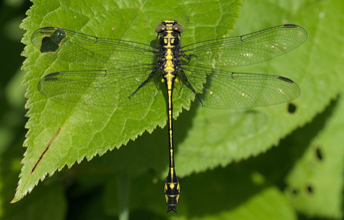Riverine clubtail
Scientific name: Stylurus amnicola

Cover photo credit: Deanna Dodgson
Status
Endangered
“Endangered” means the species lives in the wild in Ontario but is facing imminent extinction or extirpation.
Date added to the Species at Risk in Ontario List
June 27, 2014
Read the report (PDF)
What it looks like
Riverine clubtail is a small, slender dragonfly about 5 cm in length. It has a prominent club at the end of its abdomen, and the front of its thorax (the part of its body to which its legs and wings are joined) has a distinctive three-pointed star.
The abdomen is blackish with small yellow spots along the top and larger yellow spots on the sides near the tip. Females have yellow patches along the sides of the abdomen.
Where it lives
This dragonfly is found in and near streams and rivers with sandy, muddy, or gravely beds.
Larvae often burrow in the river bottom and prey on small animals such as other insects. After emerging, adults tend to move from riverbanks to the forest canopy to feed. Adults hang vertically off leaves as they await prey flying by.
Where it’s been found in Ontario
Current records of the riverine clubtail in Ontario are from Big Creek and Big Otter Creek, two streams that empty into Lake Erie near Long Point. The species is elusive, and may yet be found elsewhere in Ontario, since it inhabits neighbouring regions of Minnesota, Michigan, and southwestern Québec.
View a Larger version of this map (PDF)
What threatens it
Since much is still not known about the riverine clubtail, direct threats to the Ontario populations are not fully understood. Potential threats include:
- habitat loss from development that removes the shoreline vegetation in which these dragonflies live after they emerge from water
- invasive species such as the round goby that have been introduced into creeks where this dragonfly is found, and which could feed on young dragonflies
- water pollution from nearby agriculture and withdrawal of water for irrigation that could threaten water supply or quality for this dragonfly
- dams that could influence water supply or water flow
Action we are taking
Endangered Species and their general habitat are automatically protected.
Recovery strategy
A recovery strategy advises the ministry on ways to ensure healthy numbers of the species return to Ontario.
Read the executive summary (June 25, 2015)
Read the recovery strategy (June 25, 2015)
Government response statement
A government response statement outlines the actions the government intends to take or support to help recover the species.
Read the government response statement (March 23, 2016)
Review of progress
A review of progress made toward protecting and recovering a species is required no later than the time specified in the species’ government response statement, or not later than five years after the government response statement is published if no time is specified.
Read the report on progress towards the protection and recovery of 18 species at risk, including Riverine Clubtail (2021).
What you can do
Report a sighting
- Report a sighting of an endangered animal or plant to the Natural Heritage Information Centre. Photographs with specific locations or mapping coordinates are always helpful.
Volunteer
- Volunteer with your local nature club or provincial park to participate in surveys or stewardship work focused on species at risk.
Be a good steward
- Private land owners have a very important role to play in species recovery. You may be eligible for stewardship programs that support the protection and recovery of species at risk and their habitats.
- Invasive species such as round goby are a potential threat to the riverine clubtail. To learn what you can do to help reduce the threat of invasive species, visit: ontario.ca/invasivespecies, www.invadingspecies.com www.ontarioinvasiveplants.ca, and www.invasivespecies.gc.ca.
- The Carolinian forests of southern Ontario support an amazing diversity of plants and wildlife, including many species at risk. Carolinian Canada is working to help recover species at risk and their habitats. For more information, visit: www.carolinian.org/specieshabitats.htm.
- You can help improve dragonfly habitat and keep Ontario’s water safe and clean by maintaining natural vegetation next to rivers. These plants provide habitat for adult dragonflies, and their roots reduce erosion and can stop soil from washing into water bodies, which helps dragonfly larvae. There are many things that you can do to help keep pollution and soil from washing into Ontario’s rivers and you might be eligible for funding assistance. For more information on these and other programs contact the Ontario Soil and Crop Improvement Association: www.ontariosoilcrop.org.
Report illegal activity
- Report any illegal activity related to plants and wildlife to
1-877-TIP-SMNR (847-7667) .
Quick facts
- Members of the riverine clubtail’s genus are referred to as “hanging clubtails” for their habit of hanging vertically (tails pointing downward) when perched on streamside vegetation.
- When they are ready to breed, male riverine clubtails patrol for females in fast, low flights over streams.
- Newly emerged adults are at greater risk from predators – frogs, spiders, larger dragonflies and birds – because their exoskeletons have not yet hardened and their wings are not yet ready for flight.
